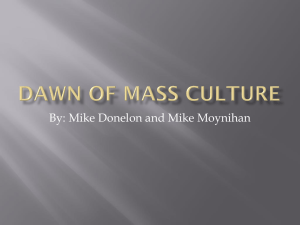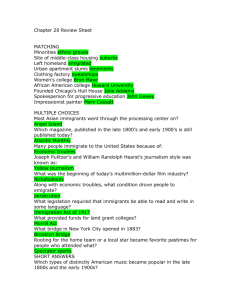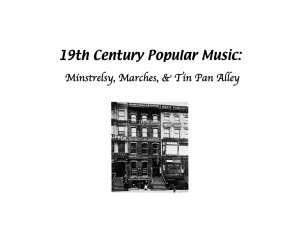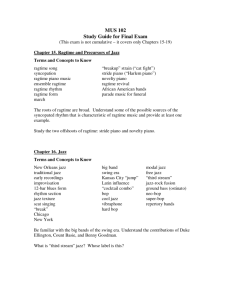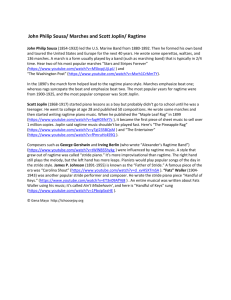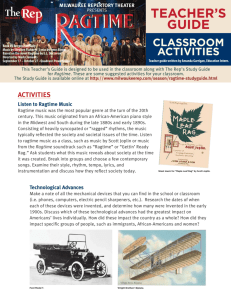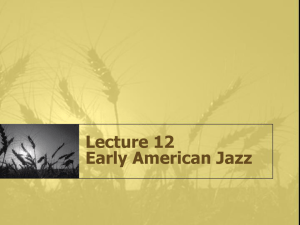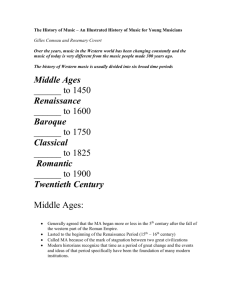Defining Ragtime Music: Historical and Typological Research
advertisement
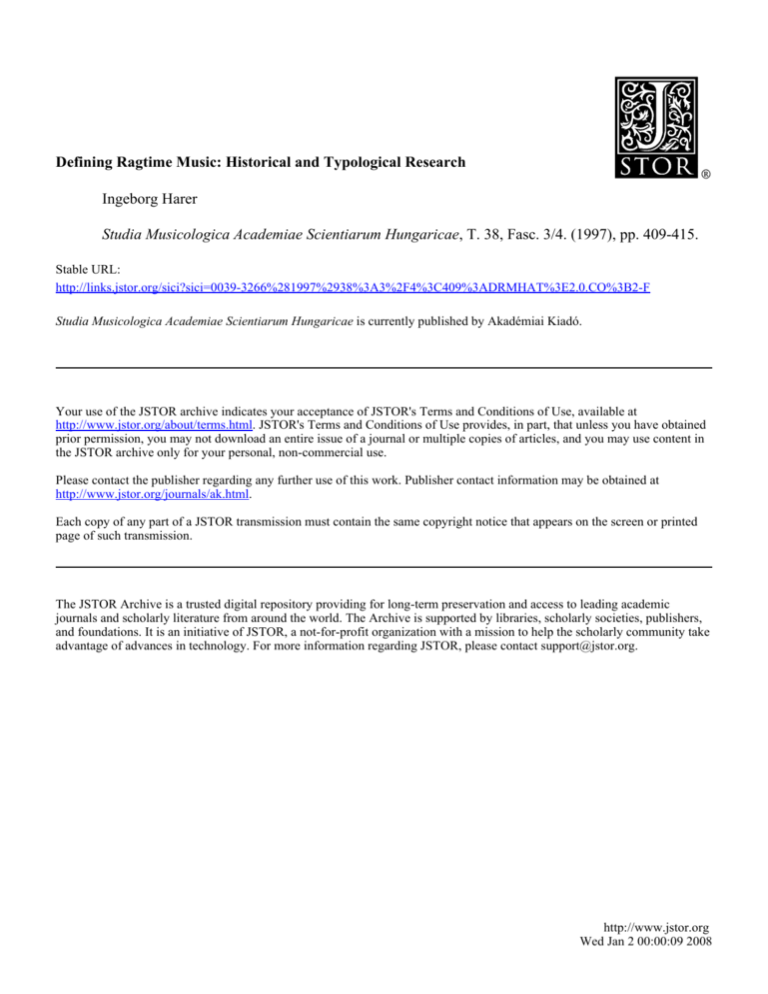
Defining Ragtime Music: Historical and Typological Research Ingeborg Harer Studia Musicologica Academiae Scientiarum Hungaricae, T. 38, Fasc. 3/4. (1997), pp. 409-415. Stable URL: http://links.jstor.org/sici?sici=0039-3266%281997%2938%3A3%2F4%3C409%3ADRMHAT%3E2.0.CO%3B2-F Studia Musicologica Academiae Scientiarum Hungaricae is currently published by Akadémiai Kiadó. Your use of the JSTOR archive indicates your acceptance of JSTOR's Terms and Conditions of Use, available at http://www.jstor.org/about/terms.html. JSTOR's Terms and Conditions of Use provides, in part, that unless you have obtained prior permission, you may not download an entire issue of a journal or multiple copies of articles, and you may use content in the JSTOR archive only for your personal, non-commercial use. Please contact the publisher regarding any further use of this work. Publisher contact information may be obtained at http://www.jstor.org/journals/ak.html. Each copy of any part of a JSTOR transmission must contain the same copyright notice that appears on the screen or printed page of such transmission. The JSTOR Archive is a trusted digital repository providing for long-term preservation and access to leading academic journals and scholarly literature from around the world. The Archive is supported by libraries, scholarly societies, publishers, and foundations. It is an initiative of JSTOR, a not-for-profit organization with a mission to help the scholarly community take advantage of advances in technology. For more information regarding JSTOR, please contact support@jstor.org. http://www.jstor.org Wed Jan 2 00:00:09 2008 Defining Ragtime Music: Historical and Typological Research Ingeborg HARER Graz Introduction Ragtime, which is always quickly associated with Scott Joplin or with turn-of-the-century piano music and described as "syncopated" music belonging to the prehistory of Jazz, turns out to become a musical genre of great diversity once a larger quantity of sources is examined. With the knowledge of its rich varieties and own unique history the procedure of defining Ragtime becomes complex. The concept of the present paper consists of three parts: 1.To gain historical knowledge about ragtime in order to establish a frarnework for analysis. In this respect not only the historical aspect of the music is of interest but the complete context of the music, its composers and time is to be kept in mind. 2. To analyse the music or to study the "anatomy" of ragtime. 3. To establish meaning between history (1) and analysis (2). On one hand definitions of ragtime attempted during the course of its history are to be regarded as products of their own times and specific aesthetics, whereas, on the other hand, pure analytical results are meaningless unless grasped within the historical framework or general context of the music. Furthermore it must be emphasized that this study is based on source material, including ragtime sheet music (1 896-1 91 7), piano rolls, and written documents such as newspaper articles from the period. The sheet music formed the basis for analysis. The selection of 260 pieces of music ("recorded" on piano rolls and published as sheet music) represents part 410 I. Harer: Defining Ragtime Music of the holdings of Trebor Tichenor's private ragtime collection in St. Louis, Missouri. Historical approach It is evident that ragtime had an oral tradition before it was written down and sold as sheet music. There are, however, few sound documents of this early period. Because it is a part of the unwritten Afro-American tradition, the roots of ragtime music are difficult to trace. In addition, at this early stage of the second half of the 19th century, the term "ragtime" has not yet come into existence, and the music which, in the course of development, contributed to formulate the musical language of ragtime manifested itself in diverse musical forms. What later, in the last decade of the 19th century, was labelled "ragtime" was played much earlier at minstrel shows, disseminated by itinerant musicians (e.g. banjo players), and performed at the same time as dance and song. As whites became fascinated by this new music, they tried to imitate this Afro-American performance style and to notate the music. By the end of the 19th century, the music was published as sheet music bearing the labels of "ragtime", "cakewalk", "two step", or other synonyms of ragtime frequently used in the period. During the 19th century, the piano had gained great popularity in American society. Ragtime piano was heard in saloons, sporting houses, ballrooms, and private homes, or at the publishing companies which employed piano players in order to promote their music. Piano rolls2 may be considered as the earliest sound documents of the ragtime era (from 1897 onwards), although these early "arranged rolls" were produced fiom sheet ' The complete catalogue of the examined rags, including incipits and analyses is part of: Ingeborg Harer, Ragtime. Versuch einer Typologie. Ph.D. dissertation, Karl-Franzens-UniversitiitGraz, Austria = Musikethnologische Sammelbiinde 9/10 (Tuaing 1989). For research on the history of ragtime since the 1980s see: Edward A. Berlin, Ragtime. A Musical and Cultural History (Berkeley 1980); Berlin, Reflections and Research on Ragtime. Institute for Studies in American Music. Monographs No. 24 (New York 1987); Alfons M. Dauer, Ragtime. Entwurf eines Entstehungsschemas und einer musikalischen Entwicklungsgeschichte. In: Ja@orschung/Jauresearch 18 (1986) pp. 155-192; Jiirgen Hunkemoller, Ragtime. In: Handwonerbuch der nrusikalischen Terminologie. 12. Auslieferung (Winter 1984185)pp. 1-11, Hunkemoller, Was ist Ragtime? In: ArchivfitrMusikwissensc~ XLII12 (1985) pp. 71-85; John Edward Hasse (Ed.), Ragtime. Its History, Composers, and Music (Houndmills 1985); Hasse, Ragtime - Sound of a Nation. In: Ragtime and Early J m . A Symposium. Edited by Alyn Shipton (Ascona 1987). The piano roll arrangers did not always produce exact copies of sheet music but made small changes, such as embellishments, doubling of chords, etc. This practice is an indication that ragtime was not always "played as written" - a postulate often later, actually in our times, applied to ragtime. I. Harer: Defining Ragtime Music 411 music which had achieved commercial success. The above mentioned synonyms of ragtime, which serve as subtitles on pianoroll labels and sheet music covers, cannot be used to define the varieties of the musical form known as ragtime. Nor does written evidence of the period - newspaper articles describing the rhythmic effects of ragtime - lead to a scholarly acceptable definition. Analytical approach It becomes evident that only systematic analysis may lead to an exact description of the styles of this music. Typological examinations seem an appropriate means to achieve this aim, when, as in our case, a larger number of pieces of music is at hand. Thus the question of "what is ragtime" turns into that of "what is typical of ragtime", as typologies always concentrate on few characteristic features while ignoring individual ones. The most characteristic feature common to all rags, and thus distinguishing ragtime from other popular music of the period, is definitely rhythm. Before rags can be rhythmically analyzed it seems necessary to examine their formal patterns in order to establish a frame for the rhythmic patterns. Roughly generalized, it is the formal pattern of three or four different 16-bar strains in the sequence of A-El-A-C-D, and the rhythmic pattern of a syncopated melody, with a more or less stable "um p a y bass line which are the dominant features of ragtime music. (There are, however, many varieties of both form and syncopation.) Each 16-bar strain (macroform) of a rag consists of four 4-bar units (microform), within which the rhythmic pattern is visible. The dependence of rhythmic analysis on macroform and microform becomes apparent when the positions of syncopations within a measure and within a 4-bar unit of a strain are located. The first step is to locate the positions of syncopations within the measure and microform. Next we can establish a numerical relationship for each note, with the sixteenth note as the basic unit. For further rhythmic analysis the transcription of the rhythmic values of the musical notes into numbers becomes a necessity. ( h. = 1, )= 2, ). = 3, J = 4. This transcription is made on the basis Contemporaneous reflections about ragtime music always centered on the rhythmic characteristics of ragtime. As mentioned above, in written documents (e.g. newspaper articles) of the ragtime era, initial attempts to define and explain "ragtime"can be found. Scotti used the terms "macroform" and "microform"but applied them in a different context. Joseph R . Scotti, Joe Lamb A Study of Ragtinre's Paradox. Ph.D. Dissertation. University of Cincinnati 1977, p. 148 I. Harer: DeJining Ragtime Music 412 Thus the combination .b.b.b turns into the rhythmic figure of 1 2 1, which, in its variety of appearances within a measure (or 4-bar unit and strain respectively), forms the "rhythmic elements" (abbreviated as REIS). A typology can be developed which relates six kinds of REs. These are shown below. RE I RE I1 RE I11 RE IV RE V RE VI /121****1 /****1211 12421 /**121**1 /1221**/ /**1221/ 1121** 11-1-1 (=cross-bar syncopation) /********I5 (* = non syncopated sections of the bar) Syncopation appears either in the first or second part of the bar producing a relatively weak rhythmic effect (RE I). Syncopation appears in the middle of the bar or across the bar producing a much stronger effect, as the main beats on 1 and 3 are sustained and additional accents are gained (RE 111, RE IV, RE V). RE I1 represents the doubling of the 121-figure and is weak in effect. RE VI summarizes non-syncopated patterns including dotted rhythms and "secondary rag".6 When the frequency of these rhythmic patterns within the individual rags is examined we arrive at three major types (and subtypes respectively). Type 1 Type 1. 1:combination of RE I, 11, VI e.g. 1 sh-ain I, 1 strain 11, 1 strain VI 2 strains I, a strain I1 2 strains I, 1 strain VI Type 1.2: RE I dominating, and RE I11 in one strain e.g. 2 strains I, 1 strain 111 (IV, V) Type 1.3: RE I dominating in all strains Type 2 Type 2.1: RE 111 (IV, V) dominating, and RE VI in one strain e.g. 2 strains I11 (IV, V), 1 strain VI Type 2.2: RE 111 (IV, V) dominating, and RE I in one strain Type 2.3: RE I11 (IV, V) dominating in all strains The position of syncopations is also discussed by Berlin, Ragtime 1980, pp. 128-130 See explanation given by Berlin, Ragtime 1980, pp. 130-134 I. Harer: Defining Ragtime Music Type 3 Type 3.1: R E VI dominating, and RE I, 11, or I11 (IV, V) in one strain Type 3.2: RE VI in all strains Depending on the position of the REs in the bar, the following variants of REs I through VI may be traced in the 3 types: Type 1 RE I - Variants 1121****1 or /****I211 (basic pattern) /13****1 or /****I31 (variant) The 121-figure is placed in the first or second half of the bar. The remaining part of the bar is unsyncopated. The pattern 12122 is the most frequent one, whereas patterns in which the 121-figure fills the second half of the bar are less frequent. RE I1 - variants 1**3**/ /**4**/ 242 (augmentation of 121) becomes the most frequent pattern. RE 111, IV and V are discussed with reference to Type 2 because they are not determining elements in Type 1. Type 2 RE I11 - variants /**121**1 1**13**1 The pattern 1112111 was most frequently used by ragtime composers. RE IV - variants 11221**I /**I2211 In these variants RE I (first or second half of the bar) and RE I11 are combined. RE V variants comprise combinations of REs across the bar. RE V - variants /121**11 -1-1 (I and V) 12411-11 (I1 and V) /**12111-1-1 (111 and V) 1122111-1-1 (IV and V) /******11-1-1 (VI and V) Combinations of V with I, 11, I11 and IV are dominating. I. Harer: Defining Ragtime Music The rags of this type are largely unsyncopated. Yet this feature needs further specification, as lack of syncopation may still produce special rhythmic effects in ragtime-music. RE VI - variants: dotted rhythm "secondary rag" "stop time" triads Synthesis In conclusion history becomes important and historical knowledge about ragtime helps to describe and most of all to understand the types: Regarded from this perspective type 1 comprises early rags including cakewalks, but also music of the cakewalk revival during the end of the ragtime era. The early forms of ragtime (at the turn of the century) reflect the stereotyical caricatures of Afro-Americans. Sheet music covers of cakewalks and coon songs, as well as their lyrics evidence this. Type 2 summarizes rags dating from the first decade of the 20th century including the representatives of what is often called the "classic school" (Scott Joplin, James Scott, Joe Lamb), or more precisely, those rags actually composed as piano rags.7 In all forms of ragtime music the degrading imagery referring to Afro-American life disappears gradually from the sheet music covers and is replaced by romantization of AfroAmericans and life on plantations, by white dance-hall images or "neutral" illustrations. This same development may also be observed in the titles and subtitles of the rags as well as in the lyrics of the songs. Type 3 mainly consists of early pieces in which the rhythmic qualities of ragtime are not fully developed, or rags of the fading ragtime era, when the transition to jazz may be seen in a gradual dissolution of the once distinguishing features of ragtime. Weak syncopation thus is a sign of early ragtime or late ragtime. The difference between these two categories becomes evident not only within the historical context but also with reference to melodic and harmonic features. (Early ragtime is less complex in melody and harmony than late ragtime). ' It is significant that Scott Joplin's rags fall with only a few exceptions within this one category, which shows a certain unity in the composer's work. For a discussionof the term "classic rag" see Scotti, Joe Lamb 1977, pp. 177-179 and Berlin, Ragtime 1980, pp. 185-193 I. Harer; Defining Ragtime Music 415 Typological examination may open deeper insight into the musical styles of ragtime, yet it is an insufficient means of defining clear lines between the varieties of this music unless additional individual and historical features of every single rag are added. It is only through this procedure that an evaluation and understanding of the musical types becomes possible.
